Razer Blade 16 review: “a luxury piece of kit for the few who can afford it”
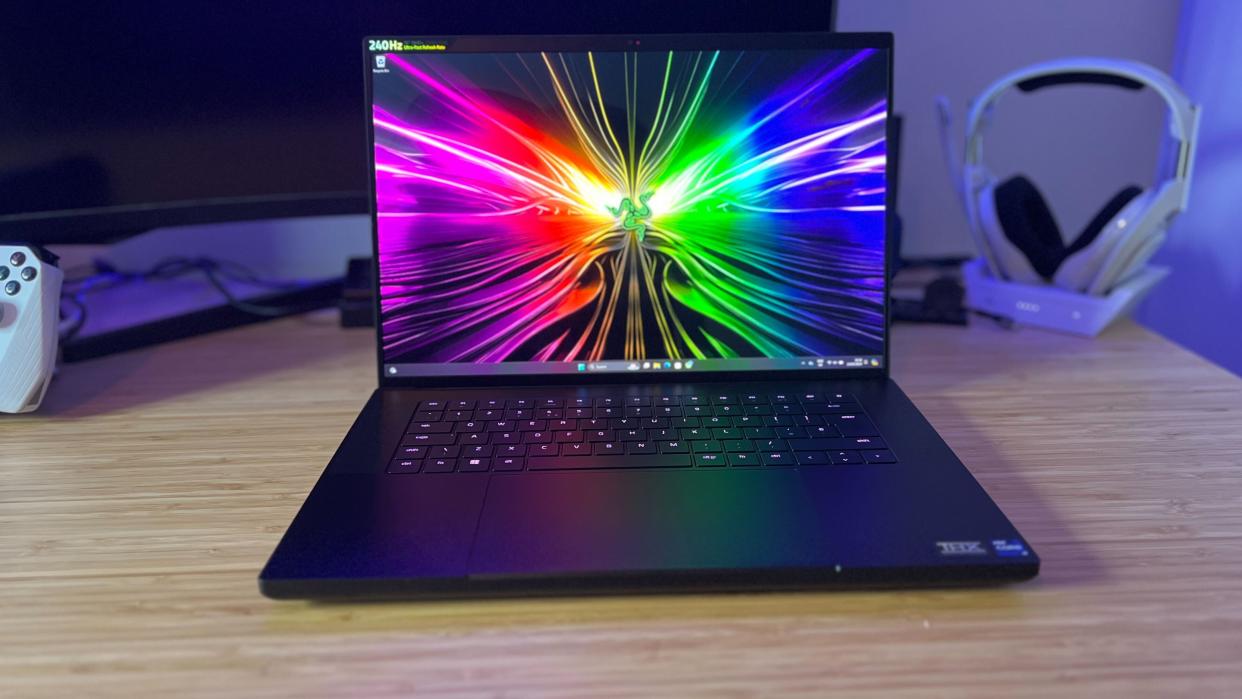
- Oops!Something went wrong.Please try again later.
This year’s Razer Blade 16 makes some big upgrades above ground, but under the hood the brand is still hamstrung by smaller iterative updates in Intel’s 14th generation processors and no new GPUs on the market. The new Blade still comes in more expensive than last year’s model, though - and that’s down to the big shiny OLED panel up top. Like many of the best gaming laptops on the market, the Blade 16 prioritizes quality of life updates in its latest iteration - but these boosts aren’t going to be worth the high asking price if you haven’t been preparing for this purchase for a while now. I’ve spent the last three weeks testing the Razer Blade 16, alongside the Asus ROG Flow X16, to see exactly what a cool $4,199 gaming laptop can offer.
Design
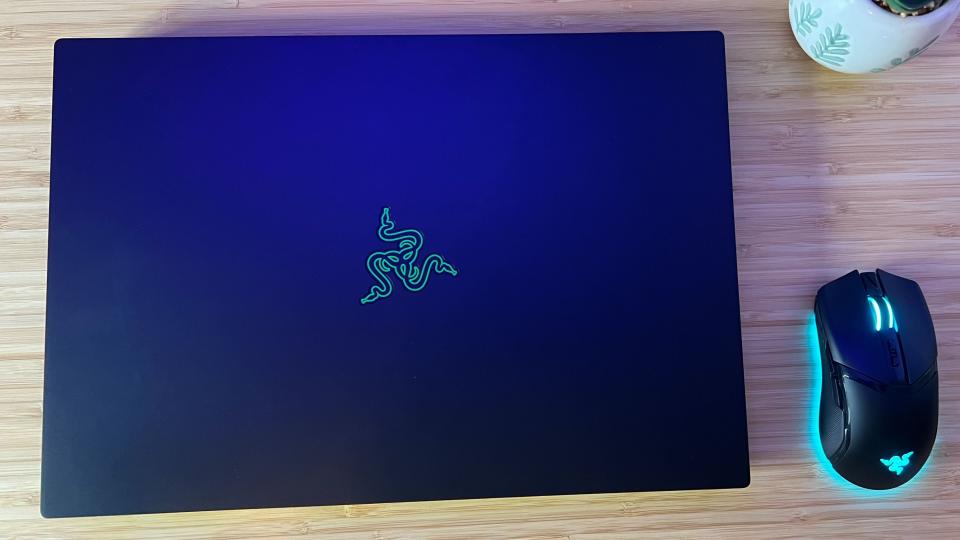
Taking over from the Razer Blade 15 as the brand’s performance/portability middle-man, the Blade 16 keeps a wide enough footprint to keep everything running smoothly while still remaining easily portable. Of course, it goes without saying, the new iteration is reading from the exact same design book as the rest of the lineup. Razer has carved its brand identity in these CNC-milled aluminum slabs, and it isn’t going to change that any time soon. That means you’re getting a slimline profile (though a slightly thicker one than the Razer Blade 14), a matte black finish, and that glowing RGB Razer logo on the lid. If you’ve seen a Razer laptop before, you’ve pretty much seen the Razer Blade 16.
Not that there’s anything wrong with the traditional Razer design. After all, these are the best-built gaming laptops on the market right now, with incredible durability, a sleek, subtle aesthetic, and rock-solid parts. A 16-inch form factor can sometimes feel unwieldy, especially if you’re traveling regularly. Chunkier models like the Asus ROG Strix Scar 16 and Lenovo Legion Pro 7i can often feel too cumbersome to truly hit that portable need, but the Blade just manages to err on the smaller side. At 2.4kg and 35.5 x 24.3 x 2.2 cm, it’s still a good deal chunkier than the more ultrabook-feeling Asus ROG Zephyrus G16, though. I didn’t struggle carting the Blade 16 around in a particularly heavy-duty backpack, but I did have a much better time when I was reviewing the G16.
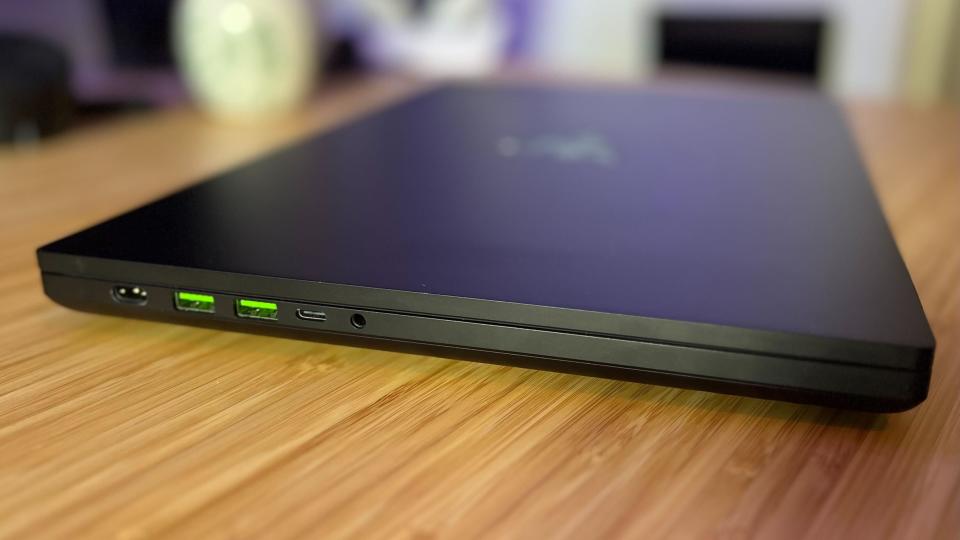
All of that’s to say, things feel a little thicker here than they do in other slimline machines. The Blade line has always been one of the more portable options on the market, and that’s only just true in this 16-inch form factor. That’s a good line to walk, though - you’ve still got plenty of space for your components to work as hard as possible without throttling.
The Razer Blade 16 is available in the standard classic black, or in a new Mercury White model - though the alternative colorway piles even more into that price tag.
Features
What’s left to upgrade when you don’t have boosted components to play with? The screen. Many of 2024’s gaming laptops are bringing OLED tech to the forefront for the first time now that the tech is fast enough to run at over 60Hz. Razer’s implementation has been crafted by Samsung, packing a whopping 240Hz refresh rate and all the usual certifications. OLED panels like this are still new, but they’re already particularly special to use. The model I received goes up to the full 240Hz, but there is an alternative Mini LED option which can switch between a 4K / 120Hz and QHD+ 240Hz to match your use-case.
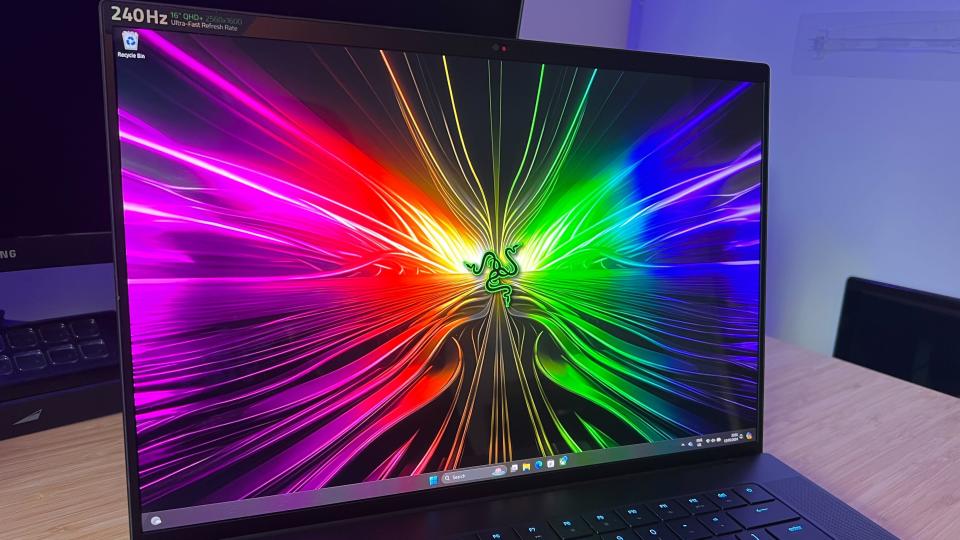
My OLED screen came out of the box a little dusky. It came pre-packaged at a particularly low brightness, and needed some tweaks to the color profile. Even at this first glance, though, I was impressed. Combined with the larger 16:9 aspect ratio, this is a particularly good-looking panel, as are most OLEDs. The glossy finish does leave its mark, though, I had a hard time with reflections when using the Blade 16 on brighter days, but with the curtains closed and the lights off this screen felt next level. You go for an OLED for contrast, but Samsung’s screen on the Blade 16 goes even further, producing incredibly vibrant color with a faithful, neutral tone and excellent motion handling.
Underneath that screen you’ve got pretty much the same keyboard as you’ll find on previous Razer Blade laptops. It’s a low profile deck with just a little travel under each key but a particularly energetic feel to it no less. Despite the size of the main deck there’s no number pad, just your standard set of keys (and a Fn row). That’s a little disappointing for those hoping to use the Blade 16 for more productivity tasks (which you’re well within your rights to do when spending over $4K). Similarly, we’ve still got half-sized arrow buttons - a little more egregious when considering the Blade’s gaming focus.
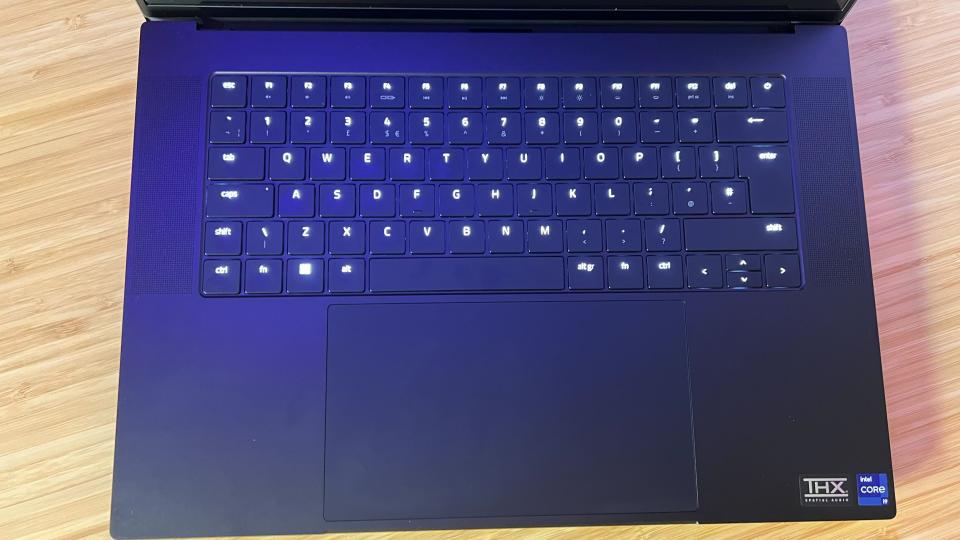
The trackpad takes up the rest of the space. I’ve always loved Razer’s pads, they never fail to offer a slick, responsive, and effortlessly gliding experience - but the sheer size of this one, especially with the limited palm space on each side, can be tricky. I was regularly leaning slightly onto the pad itself when trying to click, causing taps to fail and misclicks on occasion. I’m not entirely sure why we’ve got such a massive trackpad here, it’s nice to have plenty of sweeping space, but there are diminishing returns further up the size scale and this feels like it’s on the wrong side of that line.
A strong selection of ports meant I was able to easily connect everything I needed to when out and about, with handy placements on both sides of the machine. You’re getting one USB-C capable of running Thunderbolt 4 with a 100W power delivery system as well. Obviously, running the entire Blade 16 off one USB-C port and still trying to play more demanding games isn’t going to go well, but it’s a nice to have for a work machine.
You might not need it too often if you plan on working away from your desk. I was actually surprised by the battery life in the Blade 16. A two-hour stint in a coffee shop generally isn’t going to end in tears, even for a gaming laptop, but I was able to work off battery power for a solid four hours at full brightness. That’s much more than you could expect even from a less power-hungry Blade 14.
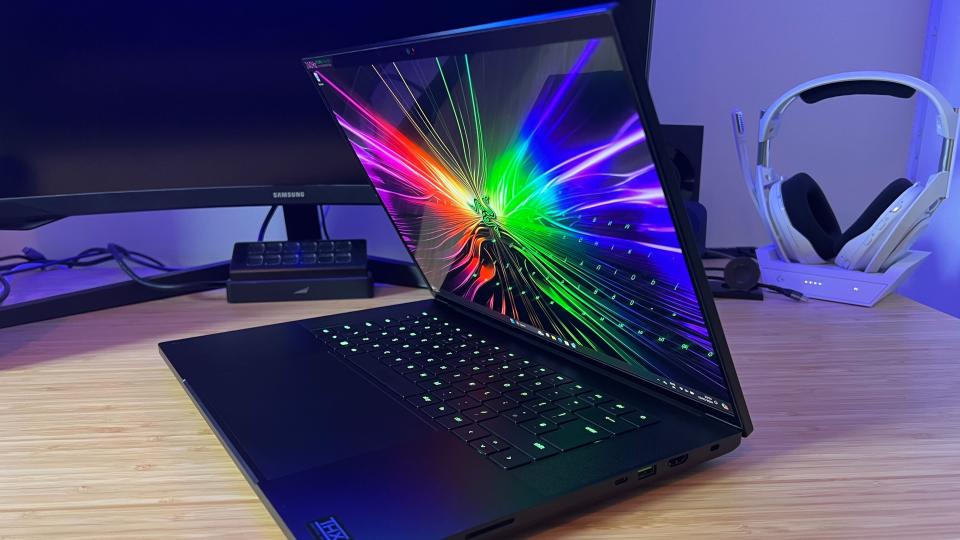
Each side of the main deck hosts a THX-certified speaker with plenty of robust power. Sound quality is impressive here, far better than I’ve heard from other machines, with plenty of detailing and a volume capable of drowning out the Blade 16’s blasting fans. Lower ranges aren’t quite as powerful, and the overall effect can feel quite top-heavy as a result, but this is still well above average.
Of course, there are plenty more smaller features added to the overall portfolio to justify that heavier price tag. A FHD webcam is a welcome addition where many gaming laptops are still content at 720p. You’ll also be able to make use of Windows facial recognition as well. Plus, all your memory and storage is upgradeable down the line as well, up to a massive 96GB RAM and an 8TB SSD.
Performance
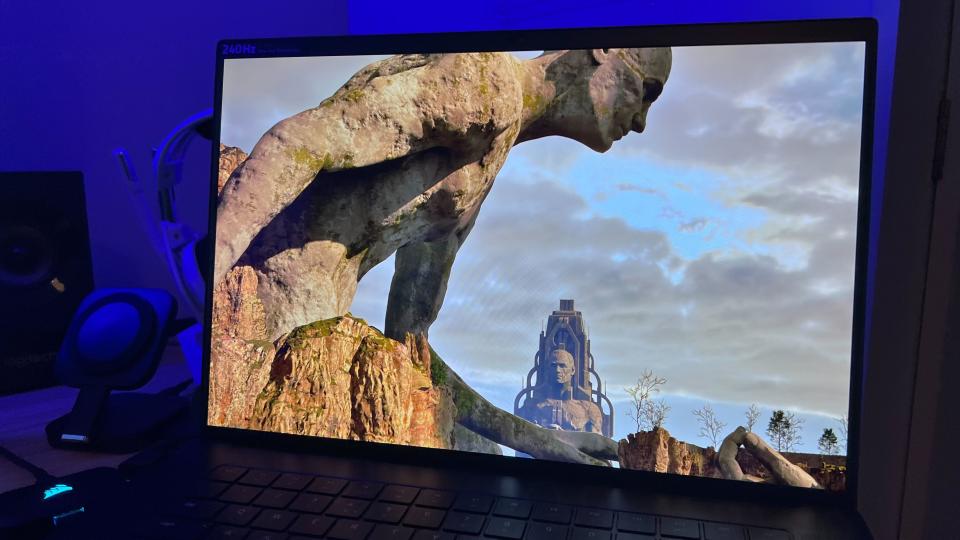
Benchmarks
Time Spy: 19,814
Fire Strike: 32,336
PC Mark 10: 8,262
Cinebench R24: 1,461
It feels a little easy to say that the Razer Blade 16 can perform. This is a $4,000+ gaming laptop - of course it’s going to run well. You don’t need me to tell you that this RTX 4090 configuration can run anything you could think to throw at it. Three-figure frame rates across both 1080p and 1600p resolutions and Time Spy / Fire Strike scores that come second only to the 2023 Asus ROG Strix Scar 18, the most powerful gaming laptop I’ve tested yet, tell the story themselves.
The Blade 16 does sit towards the top of the pack in these benchmarks, but not to the extent I would hope for considering the additional cost. Yes, it’s impressive that we’re at this level in a slimline design (the Asus ROG Zephyrus G16 does suffer from reduced performance due to its more portable design), and you’re spending that cash on quality of life features rather than sheer performance. However, if you’re spending more thinking you’ll get consistently better performance you’ll want to think again.
In-game benchmarks are impressive, putting the Razer Blade 16 ahead of both the Asus ROG Strix Scar 16 and Lenovo Legion Pro 7i. The Blade stormed the Total War: Three Kingdoms benchmark, for example, posting a 1600p / Ultra average of 105fps whereas the Legion Pro and Scar 16 were in the dust at 80fps and 87fps respectively. The Blade 16 can run in its native resolution at the highest settings and still hit framerates comfortably above that 60fps threshold - that’s not something many rigs can say. But you just don’t need to spend this kind of money to get there.
The Zephyrus G16, for example, packs an even slimmer form factor than the Blade and still keeps up with the highest graphical settings at 1600p. The end result doesn’t quite hit the same peaks as the Blade 16, but some tests did come back in the G16’s favor and you’re spending nearly $1,000 less on Asus’s RTX 4090 model.
Should you buy the Razer Blade 16 2024?
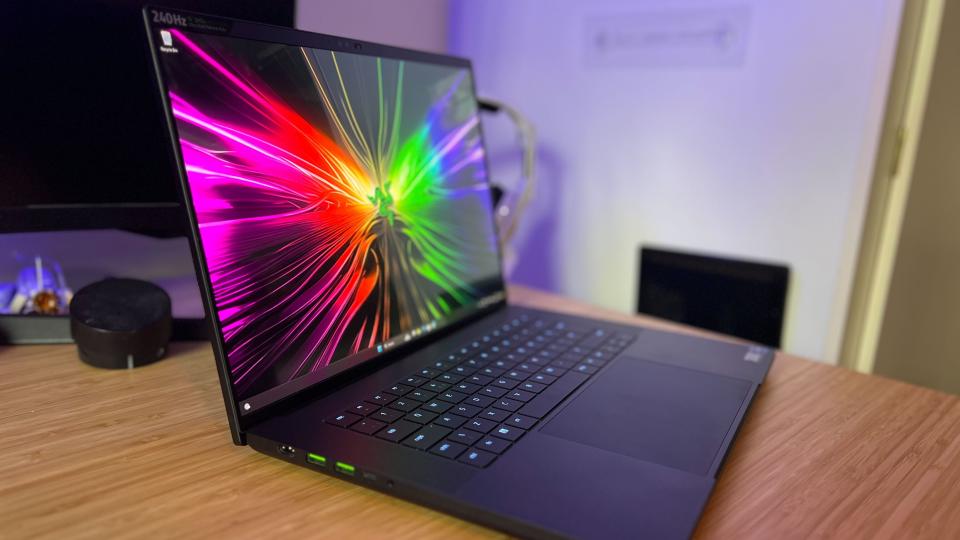
The Razer Blade 16 is an impressive gaming laptop and I’ve thoroughly enjoyed my time with it. That OLED display is well worth the investment if you’re in a position to do so, and the RTX 4090 configuration can blast through anything you’d want to throw at it. It’s insanely powerful, packs a seriously smart aesthetic, and its screen can trade blows with high-end gaming monitors. But it’s going to be out of reach for many.
This year’s iteration is even more expensive than previous models, and those releases were already hitting upper ceilings. Without the rest of the market showing us what we can get for our cash, the Blade 16 would be an incredible machine - but it’s difficult to recommend considering its lofty price point.
That’s because it’s the most expensive gaming laptop I’ve had on my desk for a long time, but it’s not the best performing. It’s a slick, slimline build but it’s by no means the most portable. In fact, the only reason I would see fit to slide the Blade 16 across the table to a prospective buyer is that screen. This is the best panel I’ve seen on a gaming laptop so far, but it’s a tall price to pay for an OLED display - especially considering so many of 2024’s releases are also packing similar upgrades in this year’s roster.
If you’ve got the cash and you’ve waited to go all out on a top-of-the-range display and the components to see you through years of demanding releases, this is where you want to be looking. There’s better overall value for money elsewhere, though.
How we tested the Razer Blade 16
I used the Razer Blade 16 for all daily work and play over a period of two weeks, with an additional week spent testing alongside the Asus ROG Flow X16. I used the Blade 16 as a solo device for most of that time, sometimes plugging into a monitor setup for longer sessions. I tested using in-game benchmark tools across Shadow of the Tomb Raider, Total War: Three Kingdoms, Returnal, and The Talos Principle 2, while also using 3DMark and PCMark 10’s suite of GPU and CPU benchmarking features. I also played Assassin’s Creed: Odyssey, Fallout 4, and Hellblade: Senua’s Sacrifice on the rig during more casual testing. For more information on how we test gaming laptops, check out the full GamesRadar+ Hardware Policy.
We’re rounding up all the best Razer laptops on the market - or, if you’re more interested in other brands, take a look at the best Asus gaming laptops and the best Alienware laptops available.

